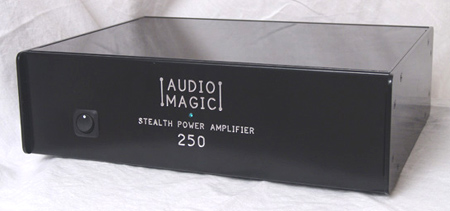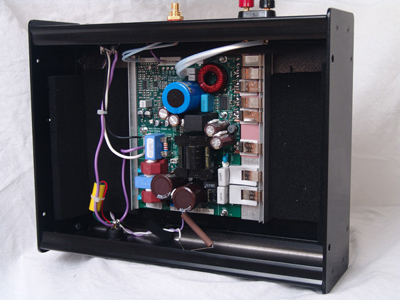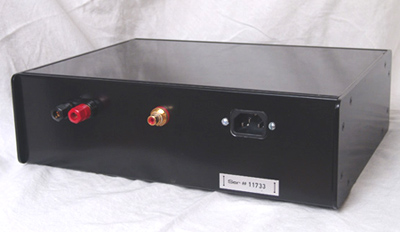You are reading the older HTML site
Positive Feedback ISSUE
15
september/october 2004
audio magic
Stealth 250 monoblock amplifiers
as reviewed by Robert H. Levi and Ed Morawski

ROBERT H. LEVI'S SYSTEM LOUDSPEAKERS ELECTRONICS SOURCES CABLES
ACCESSORIES
|
 I
wasn't sure why Dave Clark asked me to review a pair of solid state
monoblocks that retail for $3000, since every solid state amp in this price
category that I've tried with my Avalon Eidolons drove me out of the room.
The surprise was that the Stealth 250s sounded elegant on the Avalons. These
monoblocks are each the size of a dictionary, weigh less than 10 pounds, and
sound wonderful! Plus they have reference-quality bass. How can this be?
Here's what I know:
I
wasn't sure why Dave Clark asked me to review a pair of solid state
monoblocks that retail for $3000, since every solid state amp in this price
category that I've tried with my Avalon Eidolons drove me out of the room.
The surprise was that the Stealth 250s sounded elegant on the Avalons. These
monoblocks are each the size of a dictionary, weigh less than 10 pounds, and
sound wonderful! Plus they have reference-quality bass. How can this be?
Here's what I know:
These amps contain a digital amplifier module made in Denmark by B&O. The amp is assembled in the U.S. with pure silver ribbon wire in the signal path and double-coated, silver-over-copper wire at the power input. Up-market binding posts and RCA jacks are supplied, along with a detachable power cord. Each amp has a power switch and indicator light on the front. The boxes are nice looking, but rather plain, consistent with the look of the Audio Magic power conditioners. The secret is in the digital module and what Jerry does on the side (see Ed's review below for more on this secret treatment). I see the future here—it's too cool not to be.
The specs are excellent. The amps output 250 watts into 4 ohms, 300 into 2 ohms, but only 130 into 8 ohms or higher. The damping factor is a whopping 500 into 4 ohms, higher into 8. THD is a maximum of .01%, IMD is .0009% at 10 watts. These would be very nice specs for a $5000 amp, but they are superb for $3000 monoblocks that weigh less than the cardboard box they were shipped in!
I tried various power cords, and settled on Tara RSC Air1s at $750 each. They were 10 percent better than the others I tried, though only 20 percent better than standard Belden cords. Power cord rolling with these digital amps made less difference than with any amps I've ever auditioned. Here's a great way to save money—just about anything better than stock cords will be just fine. Interconnects must be single-ended, and not dull or recessed sounding. The most neutral, even-sounding interconnects I had were the Kimber Heros and Selects. I think you can safely use any upscale wire. As with the power cord, interconnects made substantially less difference than usual. No cables that I had on hand really changed the character of the sound. I heard a bit more detail with the Kimbers, but other brands were very close. I tried the amps on Zoethecus stands, and on the floor. No change! I left them on the stands for this review.
I hate to be critical about an audio breakthrough, but these amplifiers do some things extremely well, and others less well. I thought I knew the sound of tube and solid state amplifiers, as well as that of hybrid circuits. I own a particularly superb, 100% tube reference amp, I've owned Pass X600s, and I maintain a 300B SET rig as a reference, yet here comes an amplifier that sounds different from all the others. It is similar to my reference amp in that it has the ultra low grain and continuousness of vacuum tubes, and similar to the Pass X600s with respect to wide dynamics and great bass control, yet it sounds like neither. The Stealth 250s are smooth and rich without being liquid or warm. They sound like they have no distortion at all, yet they have less detail than tube amps and are less intimate sounding. Their ability to play loud without etch or grit is amazing—and unsurpassed—yet sparkle and snap is missing at all volume levels. They are 100% smooth when 75% would be plenty.
The Audio Magic 250s perform differently in different portions of the frequency range, so I will divide the audio range into three segments as follows: below 500Hz, 500-7500Hz, and above 7500Hz. Below 500Hz, they are killer! I switched off my Rel Stadium III subwoofer, and listened to the Avalons boom and slam with the best of them. Try Tchaikovsky's 1812 Overture on Telarc (SACD 60541) for powerful bass. Listen to the incredible bass fiddles on SuperBass2 (Telarc SACD 63483). Revel in Carmina Burana (Telarc SACD 60575). The 250s resoundingly beat the Pass X600 monoblocks ($16,000) on the same speakers! The bass went to the center of the earth. I kept looking at these tiny amplifiers that were running ice cold, and shaking my head in wonder. There was nary any compression or clipping. The 250s made the 11-inch Avalon woofers perform as fast as 8-inch drivers, but sound like 15-inch monsters. The bass also had a first rate sense of depth and breadth.
My quibbles were few in the bass range. Although the imaging was best in this range, it was just a bit vague. These amps need a bit of crispness in the bass to help form the images more completely. I could discern the instruments well enough, but their pacing and some of their visceral impact was compromised. The sound was a bit too smooth, and it lacked true grunt. No amount of tweaking could fix this. The bass was plenty tight, and without overhang, but was somewhat soft and slow. The Tara Power Cord has etched bass with my reference amp. It did not with the Stealth. My Kimber Silver Select speaker cables didn't speed things up or help to define images either.
In the 500 to 7500Hz range, the sound was just plain gorgeous. The amp displayed a suave, musical character, and rich but neutral textures. This was quite a sonic trick. Soundstaging was enormous and sweeping. Overall definition was excellent, and certainly well above the amplifiers' price point. The amps were ultra-listenable on all types of music. The Avalons convincingly disappeared, as they do with my tube amp reference. I enjoyed a new live performance of Elgar's First Symphony (LSO 0017CD) very much. It was spacious and very mastertape-like. Any hint of CD sound was eliminated! You cannot make these amps sound digital in any way. They are always unflappable and smooth as silk. Listen to Miles Davis blow that horn on Kind of Blue (Columbia SACD 64935). Wonderful!
Quibbles? The Stealths sound better as you listen to music lower in frequency. Baritones sound more correct and focused than tenors. Sopranos sound somewhat vague, and less textured and lifelike. Try the Carmina Burana again and compare voices, or the Getz/Gilberto (Verve SACD 314589595-2) and listen for the male and female parts. Depth is compromised as you get over about 2500 Hz, and the imaging gets less distinct. Images toward the rear of the stage are less specific than with other amps I know. Also, most of the air and ambience of the Stealth resides in the mids and bass, not the highs, which produces a charcoal gray background. The background is not as clear or black in the deepest recesses of the soundstage as that of my reference amp. The mids are a bit too smooth and bland. I miss the sparkle and snap. Instruments did not sound as real to me as they usually do. Nevertheless, the lack of grain was refreshing, and quibbles aside, this is awesome gear for the price.
The 250s' Achilles heel is in the upper end—7500Hz and above. Their specs indicate –1dB at 20kHz, but it sounds more like –5dB. There is a lack of subtle detail, air, ambience, and depth that becomes more pronounced as the frequency rises. The tweeters in the Eidolons can be merciless and etched, yet it sounded like I had managed to turn them way down. This lack of treble definition and air made cymbals and triangles sound brassy. A baritone sax sounded about right, but a flute was sort of dull. Also, strangely enough, the ceiling in my listening room seemed lower. Images were just a foot or two above the speakers, in stark contrast to the imaging that other amps produce. Smooth is good, but the 250s' upper treble is dull. Maybe Stealth's own silver interconnects would help. Kimber is not always the answer, although high-frequency airiness and sparkle are among its strong suits. This lack of air and high-frequency definition kept music from sounding as real and tactile, as it does with my E.A.R. 890. The 250s also sounded less involving and intimate. Still, the Stealth's high frequencies are very silky, and never offensive, no matter the volume level. These anomalies were less of a problem on complex classical music and rock.
I love it when a manufacturer tries something new and exciting. Audio Magic has been working its magic in cables, line conditioners, and DACs for a while now, with extraordinary success. A great amplifier is an audio manufacturer's holy grail, and the Stealth 250s may be Audio Magic's ticket to glory. They compete well with designs that cost double their price. They do some things so elegantly, and so well, that you can listen for hours and hours. They are less sensitive to AC accessories and interconnects than most amps, and simply won't clip or compress. Their smooth, luxurious midrange, lack of grain, and prodigious, reference-quality bass are a joy, but they do lack some focus, snap, high-frequency air, and upper-frequency detail and speed. Can an amplifier be too smooth? The 250s are dynamic and rich, without being warm or liquid like tube amps. They will be a better match for lively, extended, fast speakers than for laidback systems or two-way monitors. All of the 250s faults were subtractive in nature, not additive. The Stealth 250s are a cutting-edge sonic achievement, and a real glimpse into the future of amplifier design. Robert H. Levi
|
ED MORAWSKI'S SYSTEM: LOUDSPEAKERS ELECTRONICS SOURCE CABLES ACCESSORIES
|

I have been extremely interested in digital technology as it relates to audio for some time, and I find the most exciting products to be digital amplifiers. They are super efficient, small and light, and—technically speaking—distortion free, so when I was asked if I wanted to review Audio Magic's new digital monoblock amplifiers, I jumped at the opportunity. I was anxious to see if these amps were on a par with my Bel Canto eVo2 bridged digital amps.
This product is something of a mystery. There is not a word about it on the Audio Magic website, and no literature of any kind. My editor gave me a contact at Audio Magic, from whom I learned that the amplifiers are based on ICE power modules made by Bang & Olufsen, by their medical division! A Google search lead me to www.powerhouse.bang-olufsen.com/sw1022.asp, where I found quite a bit of information. ICE stands for Intelligent, Compact, and Efficient!
ICEpower250ASP is a high quality audio power conversion product generating 250 watt RMS output directly from selectable 115-230 volt mains. ICEpower250ASP replaces the conventional power supply and amplifier. Its applications are high-end audio power amplifier systems, active speakers and subwoofers, and professional audio/public address systems. For stereo, multi-channel or active applications, additional ICEpower250A amplifiers can be driven from the DC-bus connecter carrying 50V and ±12 volt DC outputs. The ±12 volt outputs of the ICEpower250ASP also provide general-purpose auxiliary supplies for external circuitry. The specs are as follows:
-
Output: 250W @ 0.01% THD+N, 1kHz, 2.70
-
Dynamic range: 112dBA
-
THD: 0.0009% @ 100mW, 5kHz
-
THD+N: < 0.05%, 0.1W - 170W, 40
-
Overall efficiency: 83% @ 100W, 80
Even though I was expecting the Audio Magic amps to be fairly light, I was surprised when handed two small boxes with one hand! They can't weigh more than a pound or two apiece, and measure only 12 x 12 x 4 inches. The appearance of the amps reminded me of a long-ago girlfriend. Roseanna was her name, and she was a true flower child, with long, stringy hair, glasses, and thrift shop clothes. Normally, you would not give her a second glance, but what attracted my attention was a tiny silver bell that she wore around her neck. I remember the first time she walked by me, that bell tinkling ever so softly. By way of a mutual friend, I met Roseanna and was immediately engrossed by her conversational skills. She was intelligent, lively, and fun. A few weeks later, I also discovered how beautiful she really was once the glasses, along with her Salvation Army wardrobe, were off and her hair brushed. I also remember fondly how much I enjoyed hearing that bell tinkling as she moved. There were magical nights when it rang for a long time! The point is that no one would give these Audio Magic amps a second glance either, and it would be their loss. AUDIO MAGIC is engraved in inch-high letters across the front of each amp, and the company didn't hire Calvin Klein to design the cabinets! They are have that look and feel of off-the-shelf "project boxes" from an electronics supply house.

Upon opening the case, I was surprised to discover just one circuit board—the ICE power module. Audio Magic sources the ICE module with an integral power supply, places it into an enclosure, adds an IEC power connector, an RCA jack, a Superior Electric speaker binding post, and a cool blue LED power indicator. Audio Magic also performs a proprietary modification. The real "audio magic" apparently comes in the form of this special, expensive treatment that is also used on their cables. I don't know about this treatment, but I am told that in blind tests, audiophiles preferred the treated versions to the untreated ones. I was not able to compare stock B&O modules to Audio Magic's treated ones, so I guess I'll just have to accept that.
All the same, the amps sound excellent. It's a testament to Bang & Olufsen that they sound so good. They have a nice, wide soundstage and superb imaging. The sound is very smooth, and I could discern absolutely no harshness throughout the audio band. Because these amps are so light in physical weight, I worried they would also be light in "audio weight," so the first CD I tried was Madonna's American Life, which has plenty of bass-heavy tracks. While the bass wasn't exactly lightweight, it wasn't room-pounding either.
My normal amps are a bridged pair of Bel Canto's eVo2s (see Ed's review). These amps weigh over 36 pounds apiece, and when you look inside, it's obvious that Bel Canto spends their money on the power supply. I would guess that the toroidal transformer, which occupies a good bit of the real estate, weighs 20 pounds by itself. There is no comparison between the two amps when it comes to bass reproduction. The eVo2s have a "Vise-Grip" hold on the bass, and never let go. At the other end of the spectrum, the Audio Magic 250s sound very pleasing. They have a delicate tone, but manage to maintain great detail, resolution, and extension. I noticed this on several CDs, but especially Norah Jones' debut album. That delicacy was never overshadowed by the mids or lows, while with the Bel Cantos, it tends to get lost. Although the Audio Magic amps are rated at 250 watts per side, they sound more like low-powered tube amps, though they never show any effort when the going gets tough. I would describe the sound as delicate, yet strong, which is a real departure from anything I've heard before.
I read many audio magazines, and pay close attention to reviews. One thing that bothers me about most reviews is that the reviewers frequently comment about how great a component sounds, but never say "Compared to what?" There are many reasons for this, of course, but if that component was so great, why didn't the reviewer immediately sell whatever he or she owned and buy the review piece? I try to be honest, but most importantly, compare review components to similar products. My recent procedure has been to listen to the review sample for a week or so, switch back to my reference for a few days, then go back to the review piece for a final week. I form opinions about components pretty quickly, but one does get used to new sounds. The revelation usually comes when switching back for the final week. In the case of the Audio Magic 250s, I enjoyed them while they were in my system, and it was only when I switched back to the eVo2s that the character of the Audio Magic amps became clear.
 Although I listened to over two dozen CDs through
the Audio Magic amps, there were two I used over and over. Alison Krauss' So Long, So Wrong is one of my all-time favorites. Track 7,
"It
Doesn't Matter," is composed of guitars and mandolin (and Krauss' stunning
vocals). It changes tempo dramatically at a few points, then throws in a few
deep bass notes for good measure. I have found it to be a great test of speakers
and amps because if they can't keep up, the bass booms all over the place.
Another favorite CD is Keiko Matsui's Deep Blue, which has a lot of
keyboards, a few difficult bass notes, and lots of detail that remains hidden if
your system isn't up to it. I played both CDs through the Audio Magic amps many
times. They handled "It Doesn't Matter" just fine. The strings were faithfully
reproduced, with all of their nuances, and bass notes were smooth and well
controlled. There was no booming at all, and I was very impressed with the
amplifiers' detail and extension. Deep Blue was even better, with a
newfound delicacy. It was like the Audio Magic amps were separating every note
and their harmonic frequencies into tiny flakes and sprinkling them through the
air.
Although I listened to over two dozen CDs through
the Audio Magic amps, there were two I used over and over. Alison Krauss' So Long, So Wrong is one of my all-time favorites. Track 7,
"It
Doesn't Matter," is composed of guitars and mandolin (and Krauss' stunning
vocals). It changes tempo dramatically at a few points, then throws in a few
deep bass notes for good measure. I have found it to be a great test of speakers
and amps because if they can't keep up, the bass booms all over the place.
Another favorite CD is Keiko Matsui's Deep Blue, which has a lot of
keyboards, a few difficult bass notes, and lots of detail that remains hidden if
your system isn't up to it. I played both CDs through the Audio Magic amps many
times. They handled "It Doesn't Matter" just fine. The strings were faithfully
reproduced, with all of their nuances, and bass notes were smooth and well
controlled. There was no booming at all, and I was very impressed with the
amplifiers' detail and extension. Deep Blue was even better, with a
newfound delicacy. It was like the Audio Magic amps were separating every note
and their harmonic frequencies into tiny flakes and sprinkling them through the
air.
When I switched back to the eVo2s, the system took on a completely different dynamic. The eVos go much lower and sound richer. Vocals have more body, the mids have more weight, and the bass has considerably more slam. I attribute a good deal of this to their heavier power supply. The Bel Cantos have much more reserve and headroom. In direct comparison, they also have a slightly wider and much deeper soundstage. Of course, it must be pointed out that just one eVo2 is twice of the price of a pair of Audio Magic 250s.
My final thought on the Audio Magic amps is that they would be a perfect match for sophisticated speakers like the Triangle Celsius or the JM Reynaud Trentes. These speakers would allow the extremely smooth and detailed sound of the Audio Magic 250s to come through to its best advantage, while having plenty of power to drive them to high levels. Ed Morawski

Stealth 250 amplifiers
Retail: $2995
Audio Magic
web address: www.audio-magic.com
Manufacturer's Response
I may have sent the stealth amps to you prematurely for review, while I really liked the way these amps were sounding all around I knew they had a few minor flaws. I just recently installed a couple of upgrades:
1. We beefed up the power supply from 5600 micro farads per amp to 19,200 micro farads per amp.
2. I also put in some additional filtering to address digital noise.
What does this mean sonically?
1. The bass is faster, tighter, and a lot more powerful in the lower extremities.
2. The midrange and the high end have more body as well with better depth and width.
All Stealth 250s will be fitted with these mods with no additional cost. Maybe a revisit is in order.
Many thanks,
Jerry Ramsey, Audio Magic
